
|   |

|   |
 e-mail: leelakaverivenkat@gmail.com Keeping legacy alive while forging new directions Photos: Lalitha Venkat September 17, 2016 "After Kelucharan, what?" was the question on every Odissi lover's mind. That Srjan, the Guru's institution carries forward the rich legacy of the master was the expectation of every Odissi aficionado - the Guru having left behind son Ratikant, with years spent under his baton in understanding the dance and mastering the technique of mardal playing, and daughter-in-law Sujatha who in performance epitomised the Guru's ideals of Odissi lyricism and grace. 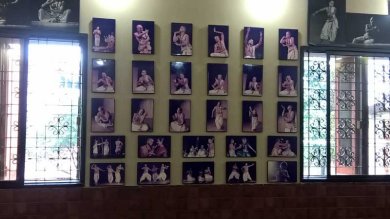 Srjan studio 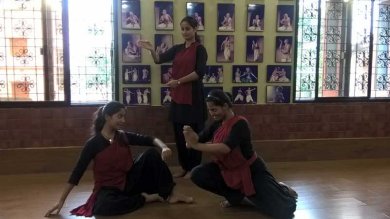 Rehearsal in progress But over the years, Ratikant, emerging out of the protective shadow of being the master's son to evolve as an Odissi activist in his own right -has surprised many critics. An excellent organizer with a savvy for surviving in the tricky cultural ambiance with its skewed dance economics, Ratikant has more than succeeded in leading Srjan, with the founder's name paid homage to through generally astutely selected Guru Kelucharan Mohapatra awardees representing different art disciplines. His own ventures in experimenting with new directions in Odissi, accepting with equanimity, unpredictable audience responses both favourable and otherwise, have shown a mature artist willing to take risks. Every facet of his life - from the way he conducts his festivals, to his home with its library on the first floor landing, replete with almirahs full of neatly arranged books, to the delightful wooden floored room for holding classes, with the walls reflecting the glorious legacy of the institution - with photographs of Guru Kelucharan performing Kuru Yadunandana, Yahi Madhava, Kevat Prasang, dancing the Gita Govindam ashtapadi in a nayak/nayika interaction with late Bharatanatyam doyenne Kalanidhi Narayanan and rendering Áhe Nila Sailo - in that order - reveals the growing confidence of a teacher who, over the years, has been discovering and finding himself. That the creative urge in him was waiting to come out was sensed by very few. Sitting in the lounge of a hotel in Bhubaneswar, I talk to Ratikant about his Odissi journey over the years in acquiring an identity of his own - aside from being the father's son. Talking about his new creations (one premiered every year during the annual Guru Kelucharan Mohapatra Awards Festival, held in memory of his father), I ask if this urge to explore with the dance, went undetected while he was with his father. "Guruji often told me to do something new, so that he could guide me by offering his comments but I felt that those were years for learning only. In 1982, I think, when Sharmila Biswas and I danced for a programme in Kolkata organised by Shyamanand Jalan (we were working with Padatik at the time), the New York branch of the Bolshoi Ballet Company approached Mr. Jalan with an offer that both Sharmila and I work with the Company in the States for three years. I consulted my mother and she was in two minds: 'You can go but you will lose three years here,' she said and later I concluded that spending 24 x7 with Baba was the more sensible option." After a few moments of reminiscing, Ratikant continues, "Baba never gave answers to questions directly. I remember his performing just one line of the Gita Govinda ashtapadi Pashyati Dishi Dishi in O.P Jain's farm stage 'Sanskriti Pratisthan' during a farewell function for the French Ambassador. Under the open sky of a moonlit night, he danced, as if possessed, for one and half hours to that one line using the entire open space, interacting with every property not omitting the backdrop with Rajasthani jharokas and the audience - with singer Ghanashyam Pattanaik having exhausted variations he could impart to the singing of one line gesticulating in wild desperation that Guruji take up the next line. I saw people in the audience like Amjad Ali Khan crying, and later observing, 'I saw God tonight' responding to the way Guruji interpreted the line. After the show, while I was pressing his tired legs (Guruji would never ask me to stop) when I asked him what had transported him, the answer was 'You will not understand even if I were to tell you. But when you reach my age (after a long journey in the art form) you will know.' "When he passed away unexpectedly his parting words to me as he gasped for breath, were 'Look after Guru Ma - she is very dear to me.' Numb with shock, sitting near his lifeless form, holding on to his feet, with Tikki (the irreplaceable friend, helper, assistant and worker for Srjan) putting a comforting hand on my shoulder, my thoughts were of quitting the dance world and doing something else. But what else was there for me?" "Days after the event, Sujatha invited to perform for Sanjeev Bhargav's impending Monsoon Festival, asked me if I could try out some new choreography for her. I approached Raghunath Panigrahi asking him for music suiting the season of 'Varsha'- and he devised a delightful score. The festival, for some reason, got cancelled. Though embarking with trepidation, the venture itself, when presented by Sujatha (with me on the mardal percussion), in Bombay later, proved a hit with dancers like Daksha Mashruwala wanting to learn the item. That gave me the confidence that I could do something on my own." "The next occasion was when I heard Aruna Sairam singing "Allah Allah". Taking her permission to record the song when she rendered it at our festival, (she was enthused when I hesitantly mentioned that I was inspired to do a group choreography based on this) I began to compose the dance. Only (my faithful friend and permanent lighting expert) Jayadev stood by me for everybody had Doomsday predictions about Odissi embarking on such a theme. The diehard orthodox lot were scandalized. But when presented during the Bijapur Festival (the area has a majority Muslim population) the response was overwhelmingly positive. The music was Carnatic, the dance Odissi, the spirit of surrender through the dance/music was to the Islamic Godhead. I felt that bringing together so many varying cultural expressions was a great idea. " Ratikant's productions include Mrityu, Bhajagovindam, Shabari, Ravan, Jatayu Moksha, Om and challenging forays into nritta through Pallavi-s based on (Pradeep's music) 9 matras (divided thus - 1+ 2+4 +2 ) and 15 matras (pancham Savari in Kathak) divided thus 4+3+4+4. His mardala expertise has helped. Have you stuck to the technique totally or gone beyond the prescribed parameters? "I have ventured beyond prescribed boundaries. For instance I use the Parshvarecita, which people feel in the straight lines is more like Bharatanatyam and not suited to Odissi." His latest Tyaaga capturing the flavour of Geetinatya in Odissi in a kind of reverse process (for the Gurus who worked on the classical format in the late fifties had connections with this art form and unconscious influences must be part of Odissi today) is, without intending to do so, on the lines of what late Debaprasad Das and late Dinanath Pathy advocated in a classical, folk, tribal continuum of the region of Odisha. Ratikant in this work has taken the typical bodily swing of Geetinatya along with the music with its typical metre while retaining the Odissi technique. What about the broad plie (chauka) of the old Odissi which has now become more the ardha chauka - closer to the araimandi of Bharatanatyam? Ratikant's revelations on how he had researched into deeper understanding of the human body with special reference to the Odissi technique, were interesting and an eye opener. Working with Davie Shetty and Ramakant Panda of Bombay (both heart specialists who had looked after Baba), had armed him with a lot of information on the body dynamics of the Odissi movement vocabulary - a process which started during Guru Kelucharan's time. Laid low by a heart condition, Guruji wanted more scientific information on how the body worked in Odissi - its energy centres and movement flow and the long term effects on the body continuously executing these movements. Regarding the chauka and the tribhangi, the main stylistic anchors of Odissi, each demanding a distribution of body weight which was very different, the specialists told him that accommodating a broad plie (chauka) with the tribhangi would, in the long run, create physical problems - which could be minimised with an ardha chauka. Father and son learnt that moving from this narrower chauka position to tribhangi, imposes less strain on the knees and hips. "We learnt a great deal about the jumps which when executed with flat footed ground contact results in knee and hip joints taking on tremendous strain. Instead, using the front portion of the feet in ground contact during jumps and making the heel contact minimal places no strain on the body. This way the strain on the body is thrown out. Similarly, holding the body with weight properly distributed without sticking out the chest or the back, are very significant features and during Guruji's time, he himself had started applying all this knowhow to movements while performing and teaching his students."You will not see the kind of chauka that Minati Misra has nowadays in our students, with the distance between the feet brought down to about a foot and not more. This was implemented by Guruji himself." Having seen the difference myself years back and questioned it, I knew that Ratikant's version was factual. He has worked on a specially devised exercise regimen, rigorously followed before practice each day and also after practice - the warming up and the cooling - and Srjan's dancers show the right posture, moving with well held, balanced bodies. Are you inspired from outside or is it something germinating in your mind that decides on the theme you embark upon for new choreography? "Both. Anything can set off the urge to do a new production." When it comes to music, the scene today is different in Odissi, with prescribed boundaries still fluid - with influences from both Carnatic music and Hindustani music (more of this now). Your father had Bhubaneswar Misra, Balakrushna Das and Raghunath Panigrahi - the likes of who are now gone. How do you decide on the music? Those halcyon years will never come back, says Ratikant, for the likes of those musicians are not born frequently. "Music for new dance ventures is an uncertain area and it is not easy. After the initial research, one needs to look around and decide on what type of music one needs for the theme in question and then approach the best person." I have seen your general preference for Lakshmikant Palit as music composer for many of your new works. Any reasons for this marked preference? "Yes. As one who knows the theatre well, and a Geetinatika participant in those days along with other forms, a composer of music with a good understanding of stage characterisation, he is easy to work with and I share a good rapport with him. I find that Rupak Parida is coming up very well lately and he is a definite asset for Odissi choreographers. But yes, music can create tensions today." Are you, like it is in the South for Bharatanatyam, thinking in terms of making music learning a part of the totality of training for Odissi? "I have already started doing that in a small way now and we will slowly make it more elaborate." 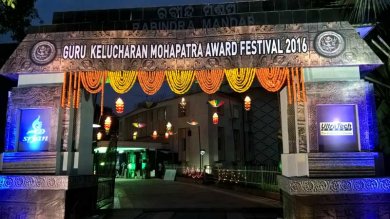
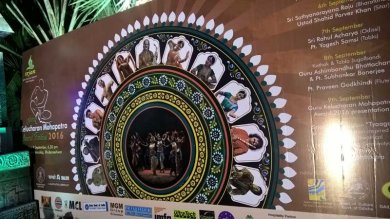
At the gates to Rabindra Mandap 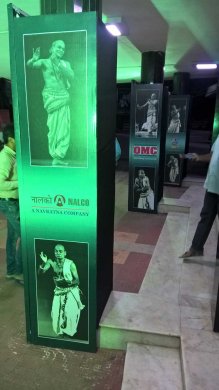 At the patio of Rabindra Mandap 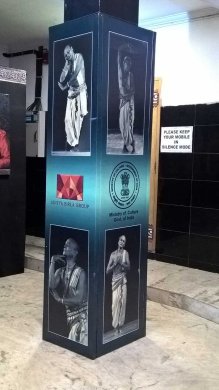 At the lobby of Rabindra Mandap Talking about the travails of raising funds for festivals, Ratikant speaks of how too many organisations today, clamouring for monetary help have made companies cut down on what was available a few years back as sponsorship support. The long hours spent waiting to present your case to department officials and company bigwigs, can be debilitating. Support without caveats is also not easy. "My artistes for the Kelucharan festival charge less than their usual amount - because of the respect they all have for Baba. But it is still a sizeable sum and a tremendous strain to raise the money." 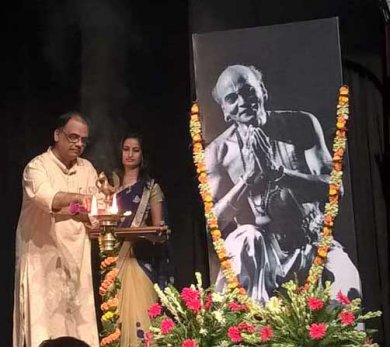 Ratikant lighting the lamp What is the audience response like? "Now new work is accepted but still there are problems. I get responses like, 'Why should the character of Meera dance to Hindi compositions? Do we not have enough Odia compositions? What is all this Rama Katha in Bharatanatyam? Why not Odissi? Why should we present other forms?'" Talking of his deep concern for inculcating in the average Odia audience a heightened sense of aesthetics and understanding of art, Ratikant says that he is still not happy that only about 100 people will sit for two hours listening to the flute of Pandit Praveen Godkhindi. "Now there is an audience for Ustad Shahid Parvez Khan's sitar - but still could be more." But many sensitive art lovers have privately admitted to this writer that it is Ratikant's festival which provides for them in Bhubaneswar the opportunity of listening to the best artists of India. Arranging festivals is not enough. To get a sensitive audience, one has to work. When one insists on invitations which have to be brought to the venue as passes for entry, there are complaints of cutting out the common man in this elitist approach. "Why then should our companies and government departments become sponsors for an event which cuts out the general public?" But when unrestricted public is allowed to come in, at times some elements become noisy and catcalls and whistles are heard, creating problems for the performers. There are very few chances for solo performers. Now every festival sponsors groups. Either way, the road ahead is not devoid of rocky terrain. "But I am a fighter and will not be deterred in doing my best for the arts in Odisha."  Writing on the dance scene for the last forty years, Leela Venkataraman's incisive comments on performances of all dance forms, participation in dance discussions both in India and abroad, and as a regular contributor to Hindu Friday Review, journals like Sruti and Nartanam, makes her voice respected for its balanced critiquing. She is the author of several books like Indian Classical dance: Tradition in Transition, Classical Dance in India and Indian Classical dance: The Renaissance and Beyond. Post your comments Please provide your name and email id when you use the Anonymous profile in the blog to post a comment. All appropriate comments posted with name & email id in the blog will also be featured in the site. |